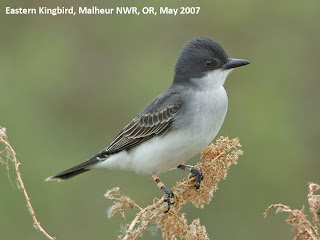I have perceived a lack of songbirds lately, and you probably have also. Not only did birds stop singing at the end of their breeding season, but most of them departed for parts unknown.
Where do these multitudes of birds go? You have to answer this question for each species, as each species has its own unique distribution. But we don't know where each individual goes, and when a Barn Swallow flies by me, I fantasize about it carrying a little flag that says "on the way to Bolivia." The great mobility of birds has long been recognized as one of the most characteristic things about them, and they use this mobility to good avail in their annual migrations.
By migrating north in spring, birds that have wintered in the tropics can take advantage of a seasonal flush of food resources, avoid competition with the great diversity of resident species, and get away from the nest predators—among others ants, snakes, kinkajous, and toucans—that are so common in the tropics. When winter comes at our high latitude, and insects and other primary sources of food are no longer available, they return whence they came.
Some of our breeders, for example Varied Thrushes that dig insects from the forest litter and Dark-eyed Juncos that subsist on weed seeds, may winter in the Washington lowlands, just downslope from where they bred. Seed-eating birds such as finches and sparrows often winter quite far north, as there is an abundance of seeds—the plant's dormant stage—at that season. So our backyard winter avifauna features seed-eaters, and many of our breeding sparrows winter not far away, in California and the Southwest.
But the majority of our small birds are insect-eaters. These birds—the thrushes, sparrows, vireos, warblers, tanagers, flycatchers, and swallows—head for warmer climes.
Many birds glean caterpillars and other insects from leaves. Leaf-eating insects become inactive at low temperatures, and leaf-gleaning birds can't find enough food to keep their metabolic furnaces stoked, so off they go. Most of our vireos and warblers winter in western Mexico and northern Central America, as do Western Tanagers, Black-headed Grosbeaks, and Bullock's Orioles.
Flying insects are even less likely to be active during winter, as they need real warmth to be able to fly. So those birds that eat flying insects can't make a living anywhere near these parts, and many of them are long-distance migrants. Western Wood-Pewees and Olive-sided Flycatchers head for the mountains of Central America, Bank and Cliff swallows and Eastern Kingbirds to the Amazon Basin, and Barn Swallows rarely make it all the way to Tierra del Fuego. These are long flights, but ones quite possible to long-winged birds such as swallows.
They’re gone but not forgotten, and they will return. Of course they leave behind many resident birds such as chickadees, jays, woodpeckers, and others, but that's another story.
Dennis Paulson



No comments:
Post a Comment